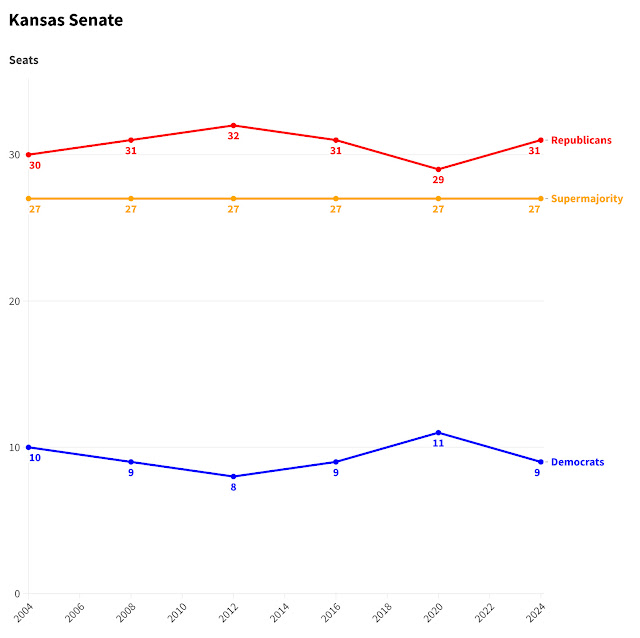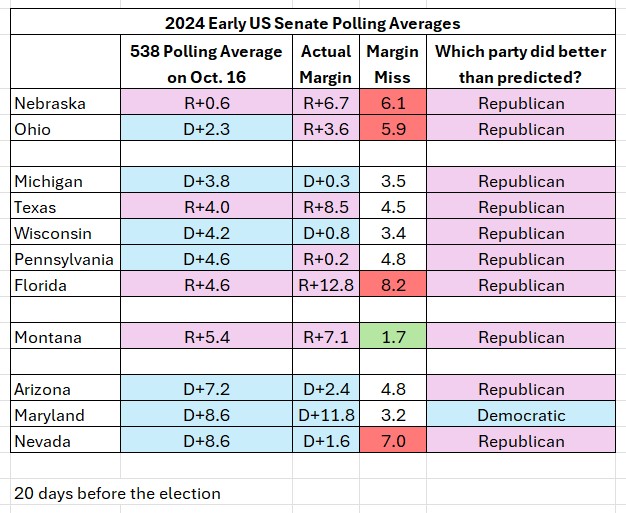In 2024, Republicans gained seats in both chambers of the Kansas Legislature.
Republicans gained three seats in the Kansas House, and two seats in the Kansas Senate.
All seats in the Kansas Legislature were up for reelection in 2024.
Elections for the Kansas House are held every two years, and elections for the Kansas Senate are held every four years.
Last year, I covered the electoral geography of elections for the Kansas Legislature, and the policies debated and approved by the Legislature.
“Key races to determine balance of power in Topeka” discussed the Republican Supermajority in the Legislature, and explored the battleground Kansas House districts.
“Republicans chip away at abortion rights in Kansas” examined the ways Kansas Republicans have limited abortion rights, even though Kansas voters decisively rejected a constitutional amendment that would have allowed the legislature to eliminate abortion rights in the state.
“Kansas Republicans approve Trans Sports Ban” discussed the transgender sports ban Kansas Republicans approved over the veto of Democratic Governor Laura Kelly.
“Stop the Flat Tax” covered attempts by Kansas Republicans to cut taxes for the rich by creating a flat tax.
This article is part of an ongoing series that explores the results of the 2024 general election.
Previously, I covered the results of elections for the US House of Representatives and the US Senate. I also evaluated the accuracy of my predictions for the US Senate elections.
Democrats can use the results of the 2024 elections for the Kansas Legislature to determine which districts are most likely to be competitive in future elections.
Many of the most competitive districts, in both chambers, are located in Johnson County.
Johnson County is located in northeast Kansas, along the Kansas-Missouri border.
About 632,000 people lived in Johnson County, and about 2.97 Million people lived in Kansas, in 2024, according to the US Census.
Therefore, Johnson County was home to 21% of the Kansas population in 2024.
That means just over 1 in 5 Kansans live in Johnson County, even though there are 105 counties in the state.
Johnson County is the largest county in Kansas, followed by Sedgwick, Shawnee, Wyandotte, and Douglas counties.
Kansas House
There are 125 members of the Kansas House.
In 2024, Republicans won 88 seats, and Democrats won 37 seats, in the Kansas House.
Republicans gained three seats in the Kansas House in 2024.
I created the graphs in this series using Flourish, a website that allows users to create compelling visual aids.
Since 2011, Republicans have held two-thirds supermajorities in both chambers of the Kansas Legislature.
The Republican supermajority allows Republican legislators to override a Democratic governor’s veto with only Republican votes.
This grants Republican lawmakers the ability to pass laws without support from any elected Democrats.
Republicans have held a supermajority in the Kansas House since the 2010 election.
The following table lists the closest 2024 elections in the Kansas House.
The table is organized by the 2024 margin of victory in each district, with the closest races listed first.
The two races listed at the bottom of the table weren’t competitive in 2024, but they were competitive in 2022.
The names of elected incumbents are followed by “(i)”.
As you can see, four Kansas House races were decided by less than 200 votes.
The margin swung in favor of Republicans in 14 of the 15 elections shown in the table above.
The margin swung in favor of Democrats in only one district, District 48, in Johnson County, where incumbent Democrat Dan Osman increased his margin of victory, compared to 2022.
Republicans flipped control of Districts 14 and 15, in Johnson County, and District 102 in Reno County.
The 2024 Kansas House races in Districts 28 and 14, in Johnson County, and District 95 in Sedgwick County, were rematches between the same candidates who ran against each other in 2022.
The following paragraphs list the counties where the districts, in the table above, are located.
The districts will be listed in the order they appear in the table, with the most competitive districts listed first.
Districts 28, 49, 15, 14, 39, 30, and 48 are located entirely in Johnson County.
District 117 is located in Johnson and Douglas counties.
District 88 is located in Sedgwick and Butler counties.
District 102 is in Reno County.
District 67 is in Riley County.
District 41 is in Leavenworth County.
District 53 is in Shawnee County.
District 95 is in Sedgwick County.
District 33 is in Wyandotte County.
Eight out of 125, or 6.4%, of the races for the Kansas House were decided by less than 5%.
Five of the eight Kansas House races decided by less than 5% were in Johnson County.
That means 62.5% of Kansas House races decided by less than 5% were in Johnson County.
Eleven out of 125, or 8.8%, of the races for the Kansas House were decided by less than 6%.
Seven of the eleven Kansas House races decided by less than 6% were located in Johnson County.
That means 63.6% of Kansas House races decided by less than 6% were in Johnson County.
Our next table also contains information about the 2024 Kansas House elections, but it’s organized by the margin of victory in these districts in 2022.
The table displays the margin of victory in the most competitive Kansas House races in 2022.
As you can see, the most competitive districts in 2022 and 2024 were largely the same.
Once again, District 48 is the only election where the margin swung in Democrats favor.
Although, Democrat Linda Featherston, in Johnson County, went from winning by 8.5% in 2022 to running unopposed in 2024, so it doesn’t really make sense to calculate a margin swing for her district.
Districts 78 and 16 are located in Johnson County.
Members of the Kansas House will be up for reelection in 2026.
Democrats would need to flip five seats in the Kansas House to break the Republican supermajority in the chamber.
Kansas Senate
There are 40 members of the Kansas Senate.
In 2024, Republicans won 31 seats, and Democrats won 9 seats, in the Kansas Senate.
In 2024, Republicans gained two seats in the Kansas Senate.
Republicans have held a supermajority in the Kansas Senate since at least the 2004 elections.
The following table lists the closest 2024 Kansas Senate elections.
As you can see, there is a large jump between the races that were decided by less than 6% and the races that were decided by more than 14%.
This is the first election for the Kansas Senate that was held after redistricting, so I didn’t include results from the 2020 elections.
The closest election was in District 5, in Leavenworth and Wyandotte counties, where Republican Jeff Klemp defeated incumbent Democrat Jeff Pittman by only 31 votes, or 0.1%.
In 2024, Republicans won all six Kansas Senate races decided by less than 10%.
All six Kansas Senate races decided by less than 10% were also decided by less than 6%.
Let’s examine those races, first.
Districts 10, 11, and 35 are located in Johnson County.
District 23 is located in Johnson and Miami counties.
District 5 is located in Leavenworth and Wyandotte Counties.
District 22 is located in Riley County.
Six out of 40, or 15%, of the races for the Kansas Senate were decided by less than 10%.
Those same races were also decided by less than 6%.
Therefore, 15% of the races for Kansas Senate were decided by less than 6%.
Four of the six Kansas Senate races decided by less than 10% in 2024 were located entirely or partially in Johnson County.
That means 66.7% of Kansas Senate races decided by less than 10% were located entirely or partially in Johnson County.
Now, let’s examine the Kansas Senate elections that were decided by less than 15%.
Incumbent Mary Ware was the only Democrat who won an election for the Kansas Senate that was decided by less than 15%.
Ware was reelected by 14.2% in District 25, in Sedgwick County.
In 2020, Rick Kloos (R) defeated incumbent Democrat Anthony Hensley in Kansas Senate District 19 by 2.1%.
That was the closest election for the Kansas Senate in 2020.
For the 2024 election, Kloos was redistricted into Kansas Senate District 3.
In 2024, Kloos won reelection in District 3 by a landslide margin of 14.8%.
District 3 is located in Osage, Douglas, Franklin, and Shawnee counties.
Members of the Kansas Senate won’t be up for reelection until 2028.
But once they are, we will have a better sense of which districts will be competitive, than we did before the 2024 election.
Democrats would need to flip five seats in the Kansas Senate to break the Republican supermajority in the chamber.























